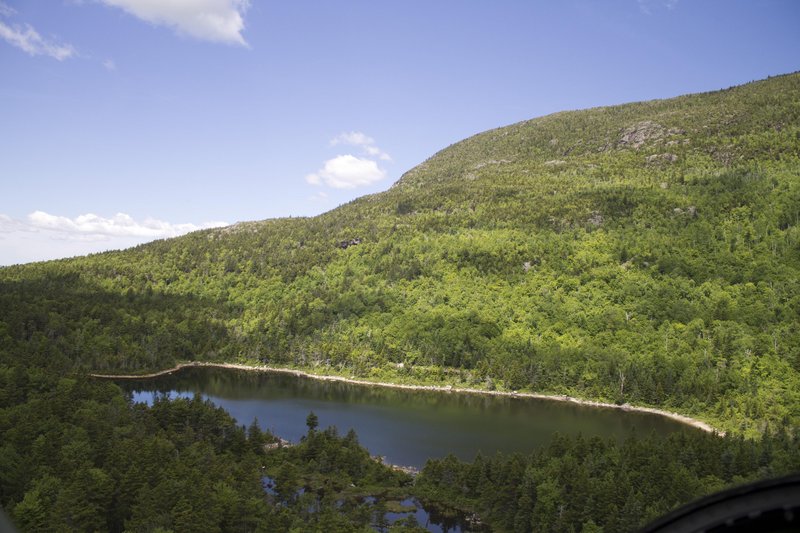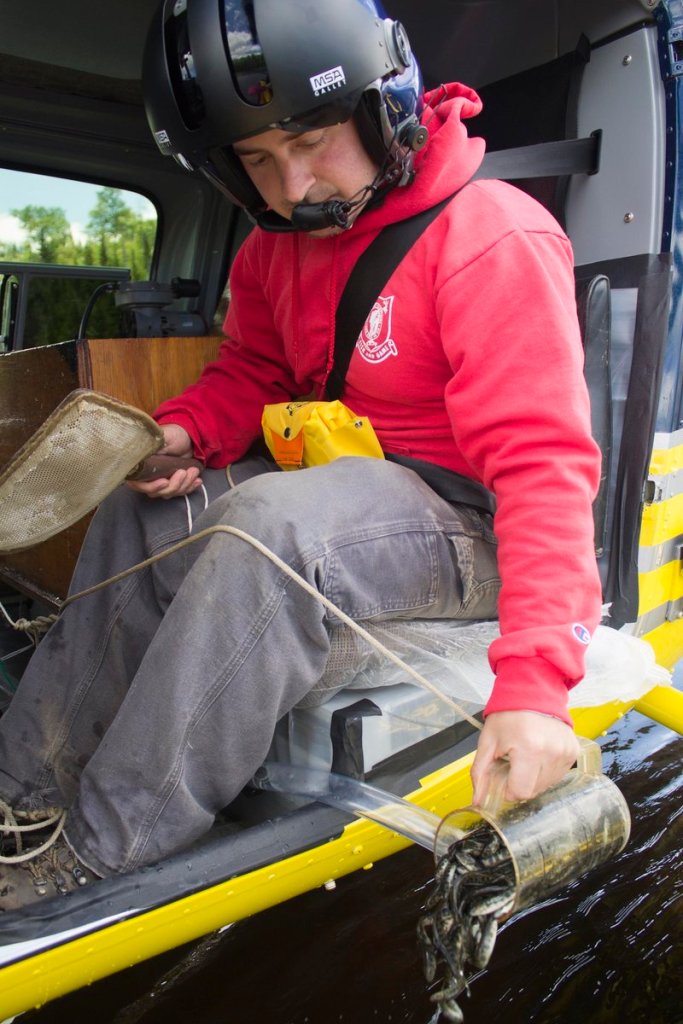ABOVE LONESOME LAKE, N.H. – Some New Hampshire ponds and lakes are so remote, the only way anglers can get to them is by hiking for miles through the woods. But the fish? They arrive by helicopter.
Thanks to the state Fish and Game department’s aerial stocking program, there’s plenty of fly fishing — and fish flying — in even the most secluded spots. On one day last week , more than 114,000 fish were dropped in 48 locations, from Lake Solitude in Newbury to Boundary Pond in Pittsburg, along the Canadian border.
“Back-country ponds are harder to get to, and because of that fact, these trout grow much larger,” said fisheries biologist Don Miller. “And the wilderness setting is something a lot of people are really looking forward to, rather than just driving off the side of the road and fishing a roadside pond or stream.”
The program’s roots reach to the early 1900s, when officials filled heavy metal milk cans with brook trout and carried them in on foot.
In 1947, the state switched to using a fixed-wing airplane to stock ponds with “fingerlings” — so called because at 2 to 3 inches long, they are about finger-length. But given the difficulty of maneuvering an airplane in tight locations, that often was a hit-or-miss operation, with fish being tossed out of the plane as it climbed back into the sky. Inevitably, some percentage of fish would end up on the ground instead of under water.
“Trying to bomb in small brook trout with a fixed wing aircraft is not always an accurate and very precise endeavor,” said fisheries biologist John Viar.
Back then, several species of fish, including landlocked salmon, brown and rainbow trout, were part of the aerial stocking program, but eventually the focus was narrowed to brook trout only.
The department switched to a helicopter in 1974, and in the past few years added pontoon floats to the helicopter skids so it can land on the water instead of having to hover over it.
Several other states have similar aerial fish stocking programs. Officials say the practice boosts the trout population in places where natural spawning can be difficult and attracts anglers seeking the solitude of remote waters.
The New Hampshire department contracts with JBI Helicopter Services in Pembroke, whose pilot Carl Svenson is an expert at navigating through the mountains of New Hampshire and landing on ponds as small as 2 acres. During one stretch of this year’s flight, he hit eight ponds in less than an hour, all the while providing trivia about the various mountain peaks as the helicopter glided past them.
Once the helicopter touches down on the water, things move quickly. Reading off a clipboard, Svenson tells Fish and Game fish culturist Kyle Dussault how much fish to drop. Dussault uses a large plastic pitcher to scoop the wriggling fish out of a large tank, leaning out of the door-less helicopter and plopping them into the water. Less than a minute later, the helicopter rises again.
The process starts in the fall, with thousands and thousands of eggs. By January, the tiny fish are moved from incubators to long, narrow pools inside the hatchery. Later, they’re moved to covered outdoor runways. At each step, there is the potential for disease and other problems, said Randall Ayer, the hatchery superintendent.
“In the past, we’ve needed a million and a half eggs just to get to 150,000 or so we want to have available for aerial stocking,” he said.
The trout are descended from a wild strain called Kennebago. New Hampshire officials acquired wild eggs from Maine in 1995 and used those to produce their own brood stock. The result is fish that retain some of their wild characteristics.
While that wildness is a plus, it also makes them a challenge to raise. The fish are cannibals, and larger fish have to be kept separate from small fish they would otherwise feed on.
But the effort is worth it to anglers like Art Rafus of Quechee, Vt., who hikes to one of the stocking locations, Cole Pond in Enfield, about half-dozen times each year.
“There’s not too many places in the area that you can get a good hike and have quality fishing like that,” Rafus said. “To be able to hike an hour to a beautiful, pristine pond that you know is not polluted water, that’s one of the best things.”
Send questions/comments to the editors.




Success. Please wait for the page to reload. If the page does not reload within 5 seconds, please refresh the page.
Enter your email and password to access comments.
Hi, to comment on stories you must . This profile is in addition to your subscription and website login.
Already have a commenting profile? .
Invalid username/password.
Please check your email to confirm and complete your registration.
Only subscribers are eligible to post comments. Please subscribe or login first for digital access. Here’s why.
Use the form below to reset your password. When you've submitted your account email, we will send an email with a reset code.